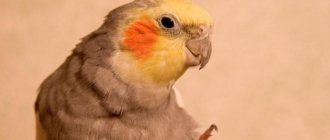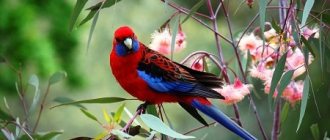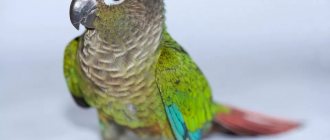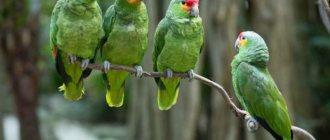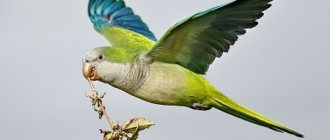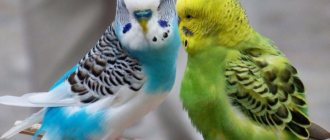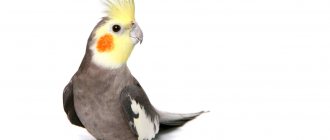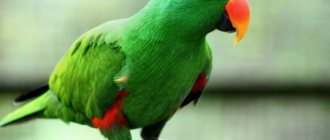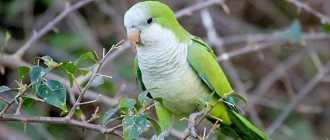General acquaintance with the view
In nature, there are three subspecies of these wonderful birds. They can be found in Paraguay, Brazil, Bolivia, Uruguay. The Quaker parrot is native to Argentina.
In many areas, these birds are considered malicious pests, as they eat and spoil fruits in gardens, and peck out farmers’ grain in the fields. Therefore, birds are often caught and sold to exotic lovers. This breed is very tenacious, hardy, adapts well to different conditions and tolerates low temperatures well. But he is a disgusting neighbor. It is not advisable to house him with other birds.
Lifestyle in nature
Monk parrots are definitely not in danger of becoming extinct in the near future, because the birds’ habitat is very wide and the population is large. The homeland of the Quakers is the northern regions of Argentina. But later parrots spread to the countries of South America: southern Brazil, Bolivia, Paraguay and Uruguay. Now Kalita inhabits the territories of Spain, Italy, Belgium, Japan, the Bahamas, Greece, Great Britain, and the Netherlands.
Kalita live in flocks of up to 200-500 individuals in dense forests and palm groves. Certain species of exotic monk parrots inhabit mountainous slopes at altitudes of up to 3000 m above sea level. Quakers move en masse to cities, away from predators and closer to food.
Appearance
The bird got its name “monk” because of the gray cap on its head. It somewhat resembles the headdress of monks.
Females are inferior in size and weight to males. It is difficult to determine the sex of birds; this is done using DNA or surgery. The female lays from 4 to 8 eggs. Birds live up to 30 years.
Purposeful breeding of this subspecies has led to the emergence of other shades of parrots through human efforts. There are also blue, yellow, white, silver of the most unexpected combination.
The description of Quaker parrots is something like this. The miracle of nature has bright plumage. The wings are a pleasant salad shade with yellow-green tints. The chest is beige with a gray coating. The tail is long and tapered. The ends of the tail and wings are light blue. Small parrot:
- Body length – 30 cm.
- Weight – 100 or 120 g.
- Wingspan – 50 cm.
- The beak is rounded, straw-colored.
These bright birds are very popular in many countries. They are purchased for children or simply to brighten up their gray everyday life. This is the name of the subspecies of parrot: monk, kalita, quaker.
All that remains is to choose a pet in a store or from breeders. There is no need to rush into choosing. You have to take a closer look, because this is a future family member.
Reproduction
Monk parakeets, unlike other birds of the parrot family, arrange nesting sites themselves, rather than looking for ready-made hollows. Quakers nest in trees, choosing higher branches, and when living in the city, on power poles, multi-story buildings and other high-rise structures.
Kalita nests, made of thin twigs and twigs, are used by them twice a year and are not replaced with new ones for several years. They have impressive sizes, sometimes reaching up to 3 m. Construction is carried out by both the male, who takes on the construction of the main structure, and the female, who equips the house from the inside.
Interesting! Kalitas rarely move into separate housing in pairs. They usually live in colonies, having a common huge nest designed for several families. But since each pair of monk parakeets arranges a personal nesting site, all Quaker families have their own entrances to the home, as well as places for hatching chicks.
How to choose a bird?
It’s better to talk to a veterinarian first so as not to miss anything, which will later lead to difficulties in maintenance or a bad outcome.
What to pay attention to:
- Age. You should not purchase an adult. It will be difficult for the bird to adapt to new conditions; it will begin to show aggression towards its owners.
- The pet's appearance is important. If he sits with his eyes closed and puffs up his feathers, it means that the Kalita parrot is sick. Quakers are very active and noisy, and any prolonged lull (except sleep) should be alarming.
- The bird's anus must be dry. If it is wet and has traces of droppings on it, it means that the individual is infected with E. coli.
- A thin monk parrot with a sharp chest is a sick bird. The reasons may vary.
If the bird is okay, you can bring it home and try to make friends.
Breeding
Many breeders specifically breed parrots of this particular species. Birds willingly give birth to offspring in captivity, and usually live longer than in the wild - up to 30-40 years versus 15 without human attention. Another peculiarity is that wild monk parrots are green-gray in color, and breeders have managed to obtain many interesting colors. There are blue, orange, red-yellow and multi-colored parrots.
It is recommended to purchase chicks from nurseries where it is well known who their parents were and that the birds are healthy. Breeders offer a certificate of the parrot's breed, as well as a personal “passport” with vaccinations against major diseases. You should not buy a chick or an adult parrot at the market, since they most likely offer illegally smuggled wild specimens; they become much less accustomed to humans, are often affected by parasites and are simply sick or weak.
Quaker character
The parrot is very friendly and sociable, and easily adapts. He learns without problems, has a good memory, and is able to remember more than 50 words and even sentences. The bell will start ringing more often in the house, the door will creak, the water will make noise, coughing and laughter will be heard - all this will be imitated by the monk parrot. The Quaker also imitates animals and birds.
Birds of this species become strongly attached to their owner. Sometimes this develops into an addiction if communication between a person and a wicket is too frequent. A long absence of communication in a bird can cause melancholy. Parrots have a strong, hoarse voice. When he starts to get bored, he makes sounds that are unpleasant to the human ear.
Getting to know and getting used to newcomers is difficult. But after that the parrots will happily begin to communicate. With a lack of attention, the bird becomes wild and aggressive, and may even die.
The Kalita parrot is a gregarious and sociable bird. Quakers mistake their owners for members of the pack. Among everyone, they will definitely choose one of the family members and will treat him especially, with increased attention and devotion.
It happens that a bird flies out of an open window, but you shouldn’t be too upset, since the Kalita parrot is very loyal and will begin to look for its way home. But there is no need to tempt fate.
Reviews of monk parrots
All reviews from owners about the Quaker indicate the importance of observing the golden mean when taming a bird. Kalita has a tendency to be hyper-dependent on her owner, so you should not pay too much attention to your pet.
At the same time, a lack of care, play and communication with a monk parrot will almost certainly have a negative impact on the bird’s character - it will become aggressive, perceiving a person as a traitor, and will constantly scream and bite. Moreover, a parrot can cause damage not only to others, but also to itself, plucking feathers and pecking itself. The same thing will happen if the gate passes to another owner, who may not be recognized at all.
Moderation in raising and taming a Quaker, as well as an informed decision about purchasing a bird so that you don’t have to give it to third parties later, will help the monk parrot become a real favorite of all family members. And only a dog can compete for primacy in devotion to the owner.
Content Features
In order for your pet to feel good and comfortable in its new home, you should consider some nuances:
- Watch the lighting. For good development and growth, the bird needs light. In the warm season, it is advisable to place the cage in the sun so that one corner of it is in the shade. If the monk gets hot, he can hide there. In winter, lack of light can lead to a deterioration in the pet's condition. Therefore, it is advisable to purchase special lamps for lighting.
- Regulate humidity and air temperature. The most comfortable temperature for a Quaker parrot is considered to be 20-25˚C. Humidity is at least 65%, but strong humidity - more than 75% - will not do any good. It is better to purchase a humidifier with air conditioning.
- When communicating with your pet, you must take into account that stress has a bad effect on it. This can cause the bird to get sick and even die. Breeders advise not to make loud and sharp sounds, to quickly flash the lights, to change the climate suddenly, and to frequently move the parrot’s cage around the house.
The parrot perceives a long stay in a cage as imprisonment. The mood begins to deteriorate, and along with it the character. The Quaker begins to show anger, irritation and even begins to pluck his feathers.
Kalita must definitely be gnawing on something. It would be nice for the bird to buy a special toy or make it yourself. Otherwise, the parrot will begin to damage furniture, doors and peel off wallpaper.
Natural habitat
The homeland of the monks is the countries of the American southern continent, such as Brazil, Uruguay, Argentina. But in the Spanish parks of Barcelona, the bird was specially bred and now numerous flocks of parrots live freely in the city park area like pigeons.
In the wild, birds form large flocks. They happily absorb the gifts of generous nature: fruits of fruit trees, berries, harvests of wheat, millet and corn fields, various herbs and even thin twigs. Farmers' crops suffer greatly from bird taste preferences.
Bird's home
Size and shape play a big role. The cage for this type of bird should be more spacious than for the usual wavy representative. The Quaker must fly in a cage. Acceptable sizes:
- Length – 100 cm.
- Height – 80 cm.
- Width – 60 cm.
Often the bird is kept in large cages outside. A house for keeping a pet should be metal, as parasites or weevils often live in wooden ones. And the bird itself will quickly turn the cage into splinters, thanks to its sharp beak.
The shape of the enclosure should have corners, that is, rectangular or square. The pet loves to hide in corners. In a round cage, without finding a place for privacy, the bird will begin to experience stress.
Classification[ | ]
The species includes 4 subspecies:
- Myiopsitta monachus monachus
(Boddaert, 1783) - southeastern Brazil, Uruguay and northeastern Argentina. Body length 30 cm, wingspan 145-160 mm. Nominative subspecies. - Myiopsitta monachus calita
(Jardine & Selby, 1830) - western and southern Argentina. Body length 27 cm, wingspan 135-145 mm. - Myiopsitta monachus cotorra
(Vieillot, 1818) - southeastern Bolivia, Paraguay, northern Argentina and southern Brazil. Body length 27 cm, wingspan 130-145 mm - Myiopsitta monachus luchsi
(Finsch, 1868) is an isolated population in Bolivia. Body length 30 cm, wingspan 145-165 mm.
Cage furniture
The photo of the Quaker parrot is touching. It’s a joy to watch your feathered friend as he climbs on different perches and rings in the cage. This is simply necessary for the bird. Especially the perches. The monk sleeps or rests on them. It is better to make the perches from hardwood trees, otherwise they will turn into splinters in the shortest possible time.
The cage door is equipped with a good lock, otherwise the gate will open the door itself. Drinkers, feeders and baths should be made of non-toxic and durable materials.
Do not forget that the parrot needs to chew twigs, sharpen its beak and claws. It is worth bringing twigs regularly. It is desirable that they contain resin and tannins, for example, from the coniferous family.
Nesting
Kramer's Parakeet
Quakers build large nests on the principle of “communal apartments”: up to twenty to thirty pairs live in one place. Massive structures can be quite noticeable, but they are made from twigs and leaves in such a way that they blend as much as possible with the trunk and branches of the tree. Much more noticeable are the kalyta dwellings built in cities.
During the mating season, males begin building nests. Parrots rarely separate and remain within the same flock, although they prefer one partner throughout their lives. Males are engaged in the construction of nests, they also protect their “consorts” while they sit on the eggs and are simultaneously engaged in obtaining food. The “team” allows you to fly off to fish alone; someone always remains to “guard” the nest. The chicks hatch naked and helpless, but at 6-8 weeks they are ready for independent life. Little Quakers either join the flock or leave it.
Pet food
Under natural conditions, the Quaker parrot eats sweet fruits, wheat, berries, and corn. At home, it is better if it is not only a grain mixture:
- Millet, hemp, flax and sunflower seeds.
- Boiled rice, corn, pearl barley.
- Lots of raw vegetables and fruits.
- Fresh grass.
- Boiled and chopped chicken or quail eggs.
There is no need to overfeed the monk, otherwise obesity will occur. But if this happens, you will have to provide the wicket with more free flight and active games in order to shed excess deposits.
Reviews of Quaker parrots are usually positive. They do not require painstaking care and special nutrition, but are prone to liver pathology. It is not recommended to feed your feathered friend with dry food. This will lead to serious health problems.
Flights and games
At first, the parrot should get used to its new home. This period lasts up to a month. Afterwards, the pet will get used to it, understand that nothing and no one threatens it, and will begin to behave more boldly. Then they slowly show more attention to him. Walking past the cage, you can say hello to the Quaker or say a phrase and repeat it daily. This is how the monk learns to speak.
If the bird begins to walk along its perch to the edge of the cage, give it a piece of an apple - they love them very much. Gradually getting accustomed to your hands, the pet will begin to eat from them and sit on your finger.
Releasing a bird to fly is a must. Playing with a Quaker is a pleasure. You can try playing football with a small ball. Tug of string works great. One end is pulled by the beak of the gate, and the other by the owner.
The Quaker parrot is a wonderful companion and friend. Neither adults nor children are bored with him. A little noisy and with a temperament, but a kind, bright and cheerful pet will enliven the atmosphere in any family.
Ability to speak
Kalita are excellent at learning to talk and are even able to pronounce words at the right time. So the pet can call the owner and other family members by name or voice what he needs now. Already at the age of six months, the pet will enjoy its first successes in imitating speech.
Feathered talkers remember about 20-30 words, however, in terms of clarity of pronunciation they are inferior to large species. More skillfully, Quakers imitate various sounds, for example, a person laughing or sneezing, household appliances, a creaking door, or a dog barking. Kalita are very musical; the pet can remember and reproduce complex melodies, substituting different words and sounds into its song.
